




One of the biggest rewilding projects gets underway
BEETLEMANIA
On the hunt for the jewels of the underbrush WALK ON THE WILDER SIDE
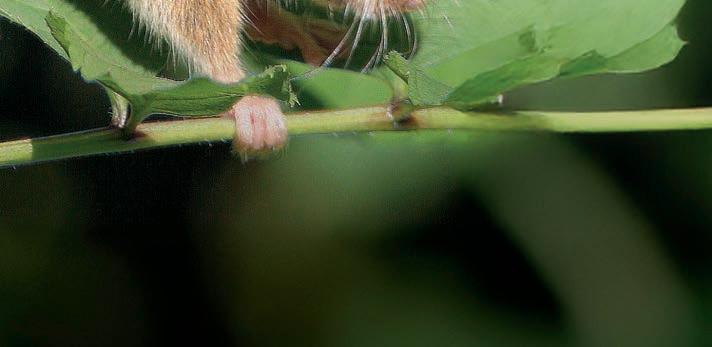











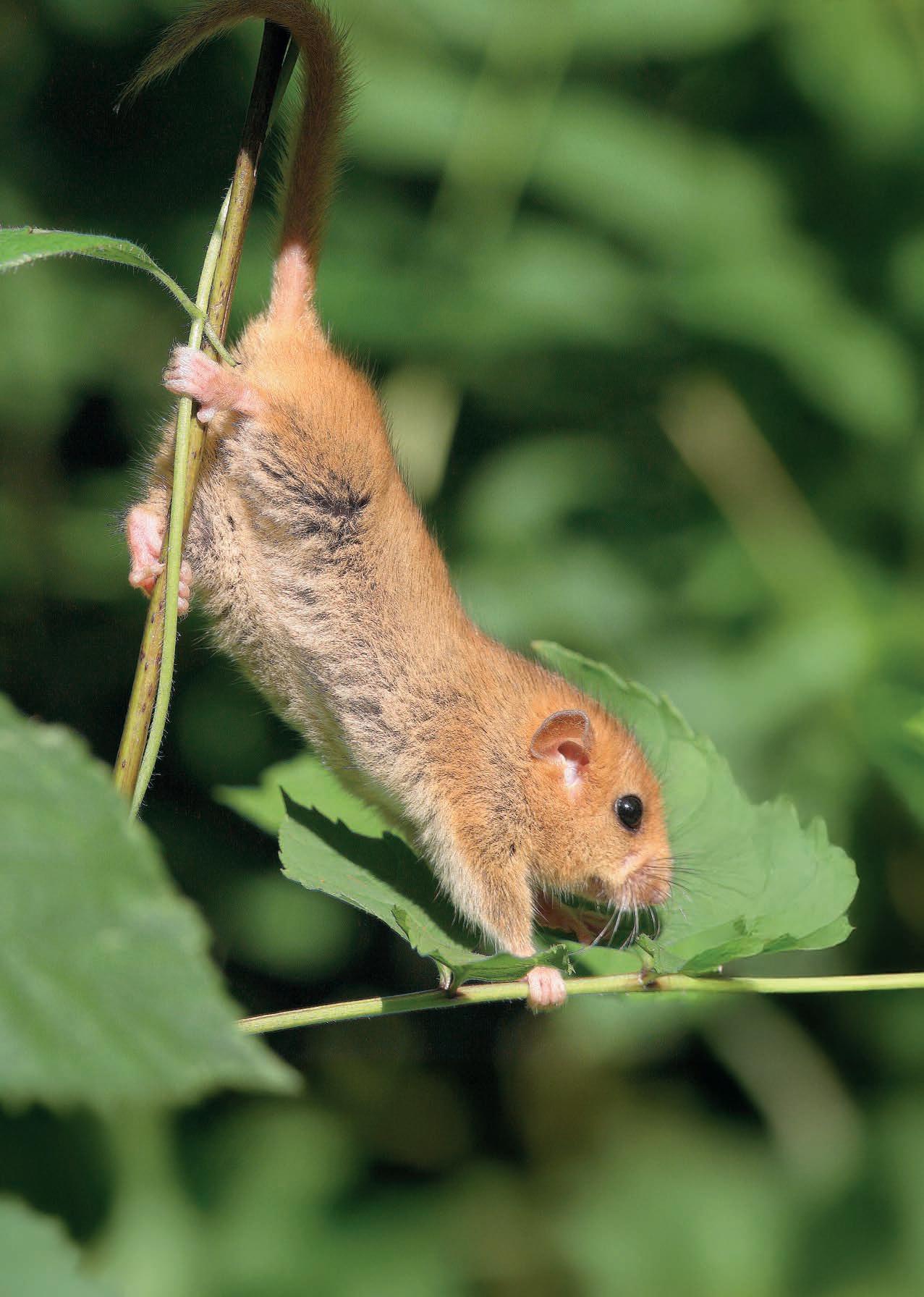






One of the biggest rewilding projects gets underway
On the hunt for the jewels of the underbrush WALK ON THE WILDER SIDE














Autumn’s arrival shines a light on the diverse habitats and wildlife we all benefit from and our determination to address its decline. This issue is a celebration of that ambition, showcasing a number of incredible nature recovery initiatives we are involved with across Leicestershire and Rutland.
We are on the cusp of some extraordinary changes. The recent establishment of Rewilding Market Harborough offers an opportunity to transform the south of Leicestershire. The project, in partnership with Harborough District Council presents a unique chance to reconnect habitats, restore lost species and invite people into a deeper relationship with nature.
Equally inspiring is the generous future gi of land at Ash Tree Farm. This remarkable act of foresight demonstrates conviction in a wilder future. It is a legacy that will help secure space for wildlife to thrive and for people to experience nature up close for generations to come.

when care, science and long-term vision combine through
One especially heartwarming story we are excited to share is the work behind the return of hazel dormice to Leicestershire. Once locally extinct, their reintroduction shows what’s possible when care, science and long-term vision combine through a commi ed partnership of concerned individuals and organisations.


All these stories speak of action and optimism on our patch, and we will continue to advise, champion and put boots on target


All these stories speak of action and optimism on our patch, and we will continue to advise, champion and put boots on the ground in the drive towards our target of 30 percent of land protected or managed in a sympathetic way for nature by 2030. There are many opportunities to restore our wild areas, and thanks to the extraordinary efforts of local individuals, partners and communities that return has already begun.
Mat Carter CEO

sympathetic way for nature by 2030. There are thanks to the extraordinary efforts of local individuals, has







WILD Leicestershire and Rutland is the membership magazine for Leicestershire and Rutland Wildlife Trust and is free to members.
Email info@lrwt.org.uk
Telephone 0116 262 9968
Address The Old Mill, 9 Soar Lane, Leicester, LE3 5DE Website lrwt.org.uk
Registered charity number 210531
facebook.com/leicswildlife youtube.com/@lrwt56 instagram.com/leiceswildlife linkedin.com/company/leicswildlife
Protecting and enhancing the wildlife and wild places of Leicestershire and Rutland and engaging people with nature.
Leicestershire and Rutland Wildlife Trust
Chair Ann Tomlinson
Co-Vice Chairs Bob Bearne, Andrew Moffat
Hon. Secretary Peter Williams
Hon. Treasurer Andy Thorpe
CEO Mat Carter
Head of Reserves Joe Davis
Head of Nature Recovery Ben Devine
Supporter Development Manager
Josephine Taylor

The Wildlife Trust Magazine Team
Editor Benedict Vanheems
Designers Kolt Graphic Design
UK Editor Tom Hibbert
UK Designer Ben Cook
Cover image Jim Higham
Views expressed in this magazine are not necessarily those of the Editor, CEO or the Council of the Trust. Articles, letters, photographs and artwork are welcomed on the understanding that no liability for their safe custody or return is incurred and the right to abridge or refuse publication is reserved.

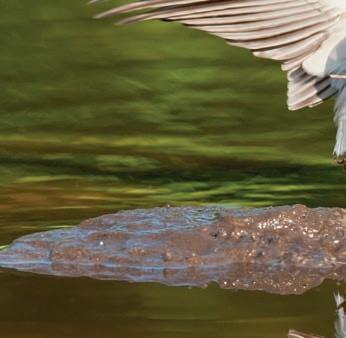


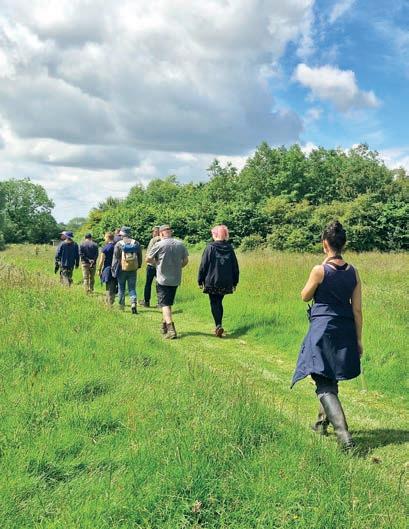


16

4 Wild news
All the latest stories from LRWT and around the country.
10 Your Wild Autumn
Follow the hedgehog on its nocturnal wanderings.
12 Welcome back! Hazel dormice return after decades of absence.
16 A walk on the wilder side
The plan to create the region’s biggest rewilding greenspace.
20 Autumn amble
Escape to the tranquillity of Kelham Bridge
22 Nature notebooks
Why we should all consider nature journalling.
24 Wonderful waxcaps
The colourful world of these grassland fungi.
26 Creating a legacy
How a landowner is helping create a wilder future.
28 Beetlemania
Admire the incredible diversity of beetles.
32 We are nature Sir Partha Dasgupta on fragmenting ecosystems.
34 Events and activities Join one of our events and feed your wild side.
Local groups Join one of our friendly local groups and make a difference for wildlife near you. lrwt.org.uk/local-groups
Campaign Play an essential role in raising awareness and lobbying on local and national issues. lrwt.org.uk/campaign
Businesses Become a corporate supporter of Leicestershire and Rutland Wildlife Trust and make wildlife part of your business. lrwt.org.uk/corporate
Fundraise From taking part in a sponsored run to organising a tea party, you could help us raise funds. lrwt.org.uk/fundraise
Volunteer Could you offer your skills and time to help look a er local wildlife? We would love to hear from you. lrwt.org.uk/volunteer
Legacy Can you include a gi in your will for wildlife and the future of our local natural world? lrwt.org.uk/legacy
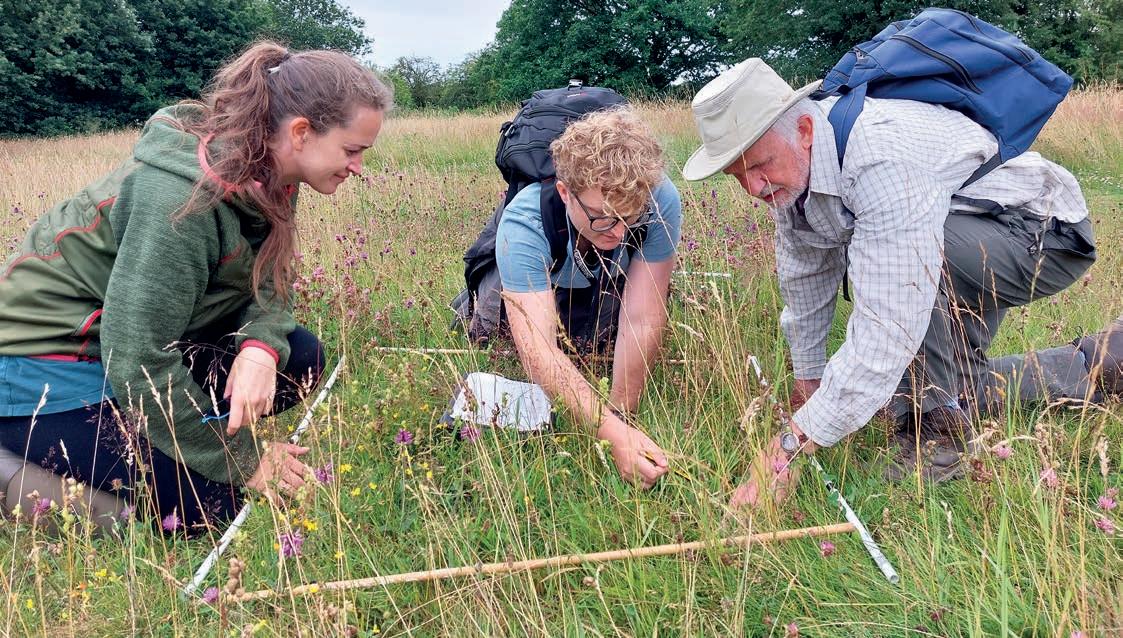
The five-year-long Charnwood Forest Landscape Partnership Scheme came to an end this summer. The hugely successful scheme sought to promote awareness of the Charnwood Forest through conservation, habitat restoration and by improving sites for visitors.
Throughout the partnership landowners and volunteers helped restore local speciesrich grasslands. Several grasslands were also surveyed, and the results used to inform their management to improve species richness. Management techniques such as hay cu ing followed by grazing should increase the prevalence of wild flowers like red clover, meadow bu ercup and great burnet, with a knock-on effect for insects like bu erflies. Some 45 volunteers were central to the success of this project.
Our wildlife identification and recording project was another key strand of the scheme. This offered training opportunities to encourage more people to record their sightings. Training events were held on a wide range of
species groups, from birds to bryophytes. Local recording website NatureSpot was promoted as part of this, with the aim of reaching 10,000 new records. Regular field meetings for a new wildlife recording group were established, with visits across many sites within the Charnwood Forest Geopark.
Specialist surveys were also carried out to investigate spider diversity in the area, with particular emphasis on rediscovering the nationally rare Charnwood Spider. Our longterm monitoring volunteers continue with their monthly bird and bu erfly surveys.
Thank you to everyone who gave up their time to support the scheme, from landowners and volunteers to the Charnwood Forest Geopark. The Charnwood Forest Landscape Partnership Scheme was hosted by the National Forest Company and made possible thanks to a grant from the National Lo ery Heritage Fund. Find out more about the scheme and how you can still get involved at lrwt.org.uk/Charnwood-forest-landscapepartnership-scheme

Interested in becoming a Trustee and helping us develop the Trust’s strategy to Bring Nature Back? There will be some vacancies on our Council at the end of the year. All types of experience are welcome, but we are especially keen to hear from people with experience in HR, supporter recruitment, green finance and advocacy. If this sounds like you, drop us a line at info@lrwt.org.uk
The formal recruitment process will begin later this year or early next.
It’s been an exceptionally exciting season for our Rutland Water ospreys. By midMarch we had both our regular Manton Bay ospreys, Maya and 33(11), back on the nest – Maya going on to lay four eggs. All the eggs successfully hatched and

Last year Maya became our most successful breeding female to date, while in 2025 the Rutland Osprey Project saw its 300th edged chick. 2026 marks the project’s 30th year! Stay up to date and be the rst to hear of their return by following us at facebook.com/ RutlandOspreyProject
the chicks – two male, two female – grew up fast. The chicks were ringed in June and at the time of writing we are waiting for them to fledge. They will continue to stay in the area until mid-August before heading off on migration, with Maya and 33(11) departing separately for the winter.
The wider Rutland area has welcomed 12 nesting osprey pairs this season, and we have loved ge ing reports of our ospreys from elsewhere in the UK. This is the first year we would expect to see any of the chicks born in 2023 return from their first migration. Incredibly, it was confirmed that all three of the chicks born on the Manton Bay nest in 2023 returned this year.
Further afield, it was wonderful to get news from Poole Harbour that the 2022 Manton Bay chick, 1H1, has successfully bred down near the South Coast. This makes her the second breeding osprey in the South of England.
One of Britain’s biggest and rarest water beetles has been discovered at Rutland Water Nature Reserve during routine water quality monitoring. Assistant Species and Recording Officer Beth Fox found two great silver water beetles (Hydrophilus piceus) in the margins of one of the reserve’s lagoons, marking the first recorded sighting of this species in the East Midlands since 1932. The beetle is listed as Nationally Scarce and is more typically found much further south.


Coalville-based David Wilson Homes has doubled the size of Syston Lakes Nature Reserve with a generous donation of land to the Trust, providing a much-needed boost to wildlife along the Soar Valley. The housebuilder has also donated us £20,000.
“Syston Lakes Nature Reserve forms a vital part of the local environment,” explains Mat Carter, Chief Executive Officer. “With this incredible gi of land we will be be er placed to ensure it continues to flourish.


The great silver water beetle is easily recognised by its large, smooth body and striking metallic sheen, from which it gets its name. Its discovery is a sign that targeted conservation efforts at the reserve are creating conditions for rare species to thrive. In the 50 years since the nature reserve and reservoir were created, hundreds of scarce wetland specialists have become established.
The find has been submi ed to the county recorder for beetles and the UK National Biodiversity Network for verification and addition to the national records.
“Syston Lakes is a favourite spot for walkers, so we plan to enhance the existing paths and open up some of the views around the reserve. The new land will be devoted solely to the protection of nature. Some of the work already undertaken by David Wilson Homes has given us a fantastic head start.”
The handover improves the connectivity of local habitats, and the Trust hopes to see more wildlife visit the area thanks to planned improvements to the land. Bird species recorded on the site include whitethroats, as well as Ce i’s, sedge, reed and spring warblers. Work to thin the tree canopy on the new land will support the se ling of these birds, while the reserve’s aquatic habitat hosts hedgehogs and numerous amphibians, including lots of toads!
Thank you to everyone who took the time to complete our recent members’ survey. We received over a thousand replies, which is phenomenal and really helps us understand how you feel about the Trust. The results are in, and we can share a few of the highlights. Your main wildlife interests are birds and wildflowers, while 88% of you visit a nature reserve at least once a year. You enjoy the events we put on, with wildlife walks and talks proving especially popular. Most of you (59%) are yet to a end a walk or talk, however,

so we hope more of you are inspired to do so!
Members are motivated to take action for nature and see conserving wildlife, tackling climate change and enabling people to learn about nature as important. We are delighted that 87% of you would recommend the Trust to family and friends, so why not consider a gi membershipsee back page for details.
Wild magazine is well received, with 94% of respondents enjoying either browsing it or reading through it more thoroughly.









Almost a fi h (18%) of you now prefer to read the magazine online. While only 37% of you follow us on social media, three-quarters open and read our regular e-newsle er. We will take on board all of your comments and continue working hard to improve the Trust and how we communicate with you.






We are delighted that 87% of you would recommend the Trust to family and friends.







The 2025 glow-worm survey season, which runs from June to July, has seen record counts at Burley Wood and Ke on Quarry, two of five key sites for the beetle across Rutland. The encouraging numbers were likely helped by the warm start to the season.
More work needs to be done to secure the glow-worm’s long-term future in the county. Plans are underway to continue monitoring next year with the help of volunteers from the Rutland Natural History



Society. The surveys not only provide vital data as part of wider efforts to restore wildflower-rich grasslands across Rutland, but reconnect us with one of our most quietly spectacular summer creatures.
Thank you for your support!
Thanks to your generous support, our Restore, Reclaim and Renew appeal has raised more than £31,000 – a remarkable achievement that is already delivering meaningful change for nature in Leicestershire and Rutland.
The money raised has enabled us to recruit a new Nature Reserve Officer. This pivotal role strengthens our ability to expand and improve nature reserves, work with more landowners, and deliver landscape-scale change.
Your support has also helped to bring together local authorities, community groups, and conservation organisations to launch the Rewilding Market Harborough initiative (see page 16). Donations continue to support our work restoring and linking important habitats and protecting the spaces that wildlife depends on. If you didn’t get a chance to give to the appeal, you can still do so by heading to lrwt.org.uk/restore-reclaim-renew

The Trust was saddened to learn of the death of Pleasance Burroughes on 30th April, aged 104. Pleasance lived in Ketton, Rutland all her life, and was a keen plantswoman and naturalist. She was a longtime enthusiastic supporter of the Trust, as well as an early participant in the Rutland Natural History Society.
The Burroughes family were great tree enthusiasts and Ketton is particularly blessed with many magni cent trees planted by Pleasance’s father and grandfather. Some of these trees can be seen in the four elds Pleasance kindly donated to the Trust several decades ago, where the Trust’s herd of sheep now pass the summer.
As well as being used in our conservation work, these elds form an important green space in the village of Ketton, acting as peaceful places where many bats, birds, butter ies and other wildlife thrive undisturbed. Pleasance’s donation was characteristic of her thoughtful nature and concern for the natural world. She will be greatly missed.




How we’ve been inspired by our members, volunteers and supporters.

creates local change that benefits both communities and nature. With the additional funding we are delighted to welcome Sally Pearce to the team as our Community Engagement Assistant. Sally has hit the ground running since joining us in February, connecting with local organisations, residents and City Council staff, and representing LRWT at events across Leicester.




Following the success of our 18-month-long Nextdoor Nature project – originally made possible thanks to generous funding from the National Lo ery Heritage Fund – we are thrilled to share that our community outreach work in Leicester continues to grow. With new support from CityFibre, we’ve been able to build on what we started, deepening our work and widening our impact across the city.
Nextdoor Nature is all about connections between people, places and the environment around us. At its heart is a community organising approach, which is a way of working that focuses on building strong relationships and encouraging collective action. This
centred, working to overcome barriers and improve quality of care.
ground running since joining local organisations, residents representing LRWT at events and inspire local people to take diversity and vitality of our city.
Sally has also been delivering pollinator-friendly gardening workshops, helping to upskill and inspire local people to take practical steps for nature right on their doorsteps. Her energy and creativity are already making a big impact and the work she is leading reflects the diversity and vitality of our city.
One project Sally is supporting is the wellbeing allotment run by The Race Equality Centre (TREC). TREC supports individuals who are vulnerable, disempowered, socially isolated and o en disconnected – not just from their own communities but from wider society. Their approach is holistic and person-
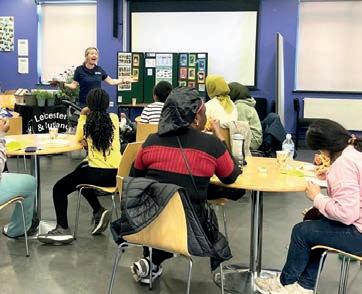

TREC welcomes individuals, families and youth groups to the allotment to take part in outdoor activities that offer learning opportunities, a space to relax and support for improved mental wellbeing. Keen to enhance the site’s wildlife-friendly potential and promote sustainable living through food growing, TREC is working closely with Sally to deliver engaging workshops and demonstrations. Together they are increasing the site’s biodiversity, with plans already in place for a dead hedge using materials collected and supplied by our reserves team.
Following a workshop one a endee wrote: ‘The session with Sally yesterday was so enjoyable. Thanks to Sally, our awareness of the bu erflies and plants in the city we live in has increased.’
Sally will also lead food growing and composting workshops, supporting the group to create a new composting area where they can learn about sustainable living and consider their carbon footprint.
With people at the heart of our community work, this kind of collective action is what Nextdoor Nature is all about. It is a privilege to support people in making these changes and to see how the ripple effect of small, local efforts can turn into something truly meaningful.



If you would like to learn more about what we’re doing, or get involved yourself, please get in touch with Sally at spearce@lrwt.org.uk or call 0116 262 9968.



Anew report commissioned by RSA Insurance, an Intact company, and The Wildlife Trusts shows that every £1 invested in Natural Flood Management (NFM) is expected to deliver £10 of benefits over 30 years. Nature is one of the best defences against flooding in a changing climate, but the partners behind the report believe that more investment, data and support is needed to increase its long-term positive effects.
Natural Flood Management means investing in beaver wetlands, creating ponds, restoring bogs, rewilding rivers and de-paving so that these areas can soak up water and hold it back in times of high rainfall. Evidence collated by the Environment Agency shows that natural flood management is effective at reducing the overall damage from flood risk; the new report has gone further to focus on wider benefits including be er habitats for wildlife, carbon storage and improvements to health and well-being.
Alongside the devastating impacts that flooding can have on people, it is the UK’s most expensive natural hazard, costing approximately £2.2 billion annually. This is projected to rise by a range of 19-49% by the 2050s according to the UK’s latest Climate Change Risk Assessment.
The new research looked at 10 Natural Flood Management schemes created by individual Wildlife Trusts. Collectively, they had an average total cost-benefit ratio of 4:1 over 10 years rising to 10:1 over 30 years.
Kathryn Brown, director of climate change and evidence at The Wildlife Trusts, says: “One in six houses across the UK is currently at risk of flooding and climate change is leading to more frequent and heavier rainfall – and we know that this will become more severe in the future. The good news is our research proves that restoring natural habitats can help us tackle the effects of climate change – and in doing so, help reverse nature declines.
“The economic benefits of investing in Natural Flood Management are clear but just 1% of the public funding for managing flood risk in England goes to Natural Flood Management. Natural approaches to water management should be the UK Government’s first port of call wherever appropriate – and we need to see such benefits regularly accounted for, measured and valued by both the Government and private sector in future.”
To read the full report and find out more about Natural Flood Management, visit wtru.st/Natural-Flood-Management
• Upper Sherbourne, Warwickshire Wildlife Trust: Leaky dams and retention pools installed to help stop properties and roads flooding in a suburb of Coventry.
• Limb Brook, Sheffield & Rotherham Wildlife Trust: Wetland expansion, 20 a enuation ponds created, 50+ leaky dams installed, de-culverted streams and hedge planting.
• River O er, Devon Wildlife Trust: Wetlands restored by beaver dams, which can reduce flood flows by an average of 30%, even during wet (high flow) conditions.
• Gloucester & Cheltenham Waterscapes, Gloucestershire Wildlife Trust: 50 homes will benefit from decreased risk of flooding due to the creation of rain gardens, de-paving driveways, green verges, a enuation ponds and scrapes, which were delivered through RSA funding.




Earlier this year, The Wildlife Trusts celebrated the UK Government’s decision to licence reintroductions of beavers into the wild in England and acknowledge free-living populations for the first time in 400 years.
The Government’s decision to accept applications to return beavers into river catchments in England enables this native species to roam wild in our rivers and lakes once more.
In Wales, The Welsh Beaver Project, led by Wildlife Trusts in Wales, is currently waiting for the Welsh Government’s decision on the protected status of beavers following a consultation.
Currently, only 14 per cent of rivers in the UK are considered to be in good ecological condition. Beavers are natural ecosystem engineers – experts at creating healthy wetlands. Their dams retain, release and filter water, restoring natural wetlands, river processes and wildlife too.
The Government recently commi ed to spending billions of pounds on hard infrastructure to combat flooding as well as compensating farmers for lost crops due to changing weather pa erns. Releasing beavers represents a naturebased solution to many problems our rivers face and is shown to significantly reduce flood peaks, as acknowledged by our report into natural flood management.
The return of beavers has been carefully planned over a long period of time. Natural England has developed a detailed licencing regime and application process so stakeholders are engaged, landowners supported and wetlands are created to improve wildlife and the health of rivers.
To find out more information about wild beavers near you, visit wildlifetrusts.org/beavers


Cambourne show that new housing developments and nature can exist in harmony.

The Wildlife Trusts are disappointed to see measures to boost nature’s recovery largely absent from the most recent UK Government’s Planning & Infrastructure Bill. Although the Bill shows some safeguards to the Nature Restoration Fund, including an ‘overall improvement test’, these need to be stronger.
Becky Pullinger, head of land use planning at The Wildlife Trusts, says: “If the UK Government is serious about recovering nature alongside meeting
housebuilding and other development targets, it should introduce Wildbelt designation in the bill – protection for areas of land which could be earmarked for future nature recovery – as well as a promise to protect Local Wildlife Sites.
“We have just ve years to meet legal targets to halt the decline in biodiversity. So, we need to ensure public, private and charity investment in habitat restoration on key sites is protected for the longer term.”



Discover how The Wildlife Trusts are helping wildlife across the UK


















Manx Wildlife Trust in collaboration with Visit Isle of Man announced the inaugural Biosphere Photographers in Residence for 2025. Ciara Hardisty and Adam Morgan’s work will contribute to a lasting artistic legacy that highlights the Isle of Man’s distinctive status as the world’s only whole nation UNESCO Biosphere Reserve.
The only native British species in the World’s 100 Most Threatened Species list was discovered by Leicestershire and Rutland Wildlife Trust at Rutland Water. The willow blister fungus (Cryptomyces maximus), recorded in England for only the second time since 1876, was previously only known in a few places in Pembrokeshire.
A recent egg count of the rare brown hairstreak butter y on the Berkshire, Buckinghamshire & Oxfordshire Wildlife Trust Asham Meads nature reserve in Oxfordshire revealed 43 eggs and a 33% increase on 2022. Despite increasing threats from climate change and habitat loss, stable numbers were recorded here.

wtru.st/brown-hairstreak






Hedgehogs can swim surprisingly well, with their air- lled spines aiding buoyancy. During hibernation their heart rate slows from a rather rapid 190 beats a minute to just 20.



Hedgehogs are nocturnal creatures, scurrying around your neighbourhood at night, visiting allotments, gardens and the hedges around sports pitches and recreation grounds. Late summer and autumn evenings are a good time to see these delightful mammals snuffling through the leaf li er beneath hedges on the lookout for beetles, caterpillars and worms.
The average adult hedgehog has 5,000 to 7,000 inch-long spines over most of its body, with grey-brown fur on its face, chest and belly. A ract them into your garden with special hedgehog biscuits and shallow saucers of water they can easily
drink from. Start making piles of leaves and wood in a quiet corner ready for them to hibernate over winter.
SEE THEM THIS AUTUMN
In parks: Parks with lots of hedges around the edges offer the best chance of spo ing a hedgehog. Head out for a dusk walk and keep an ear out for their rustling.
In your garden: Hedgehogs may visit your garden too, if they can easily walk in and out. Make holes in fences with your neighbours to create a hedgehog highway. Find out how at lrwt.org.uk/actions/ how-create-hedgehog-hole


Thank you!
Your membership helps protect mammals like hedgehogs by funding work on our nature reserves and in the wider landscape.
These wintering ducks arrive on our patch from September.
Wigeon are beautiful dabbling ducks and a familiar sight on wetlands, gravel pits and reservoirs over winter. Listen out for their distinctive whistling calls as they wheel through the sky in large flocks before landing on grassy banks and flooded fields.
The wigeon is a medium-sized duck with a round head and short bill. Males are grey with a pink breast, orange head, yellow forehead and white wing patches easily seen when they fly. Females have rusty brown plumage and a pointed tail.
Wigeon arrive at Rutland Water from September. By January at least 4,000 birds will be whistling and wheeling in the skies.
This year marks the 50th anniversary of the Trust’s Wetland Bird Survey at Rutland Water. Surveys are carried out every winter by trained volunteers spending many hours

The Motus tracking station at Rutland Water will help us identify more of the birds and mammals that overwinter here.
watching and recording the tens of thousands of wetland birds, including gulls, swans, ducks and other wildfowl that make Rutland Water their winter home.
Wetland Bird Survey data contributes to the International Waterbird Census, and the designation of Rutland Water as a wetland of international importance.
■ Stars of the show: The smew is a star winter duck at Rutland Water. Males have shaggy white crests and black eye patches; females are redheads.
■ Winter welcome: Rutland Water is a top place for waterbirds to spend winter where
they feed and roost on the lagoons, islands, scrapes and banks.
Is your garden ready for the colder months? Making winter wildlife at home starts now.
Add log piles Dig a log pile into the ground to provide damp shelter for insects – and a convenient bu et for frogs, birds and hedgehogs!

Clean feeders






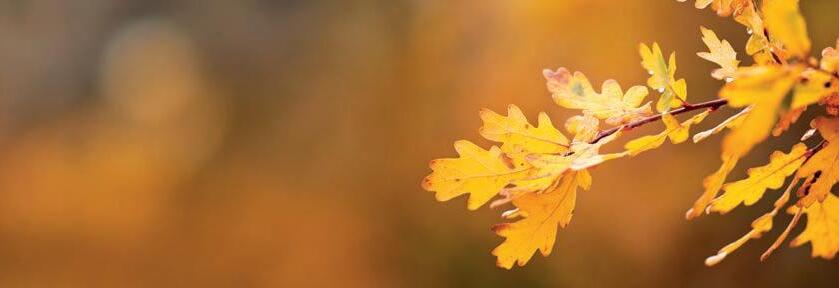
The leaves of deciduous trees start to change colour as daylength shortens and temperatures fall. Cold nights destroy the chlorophyll that produced green leaves in spring, which fades to reveal the yellow pigment of carotenes. In dry, sunny autumns, the anthocyanins that produce reds and pinks become more intense, especially if temperatures remain above freezing.

Ivy bees are newbies to the Midlands! These solitary bees nest in loose, sandy soil and feed almost exclusively on ivy, which owers from September to November.
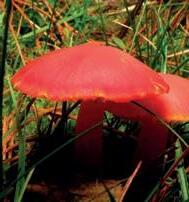









Regularly clean bird feeders to remove any mouldy seeds or mealworms.




O er energy-dense foods like suet, peanuts and seeds.
Frog’s retreat
Sink an old washing up bowl into the ground and ll it with rainwater. Add a few large pieces of broken owerpot as hiding places for frogs.

Nest-ready
Take down and clean out nestboxes to prepare for next spring’s arrivals. Scald surfaces with boiling water to kill any parasites.
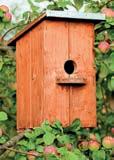
Visit Merry’s Meadow to spot grassland fungi such as crimson waxcap, one of several species found here. See page 24 for more on waxcaps.


After decades of absence from Leicestershire, hazel dormice are set to make a comeback thanks to a recent release in the county. This landmark reintroduction, along with others around the country, o ers hope for this much-loved yet increasingly rare mammal.

Dormice are born hairless and blind into a nest woven from shredded bark, leaves and grass.

Hazel dormice, with their golden fur, large black eyes, fluffy tails and twitching whiskers are perhaps the most treasured of all our small mammals. Weighing no more than 35g – less than a standard golf ball – dormice spend most of their day fast asleep, waking at night to scurry about and climb high into the canopy on their search for supper. When you look as cute as this, it’s hard not to fall for these beguiling sleeping beauties!




Top of the menu for the hazel dormouse is, unsurprisingly, hazelnuts, with other nuts seeds, berries and insects making up most of the rest of their diet. Nuts and seeds are especially energy dense and essential for laying down fat ahead of their winter hibernation, which can last as long as seven months. Then as they emerge in spring, it’s a ma er of eating whatever can be found, including the blossom of trees such as oak, hawthorn, willow and sycamore.
Dormice are typically found in woodland with plenty of new growth from woody plants. It’s a habitat that is ideal for many other species too, including woodland birds, bats and bu erflies, which makes the presence of dormice a reliable indicator that a woodland is healthy and has a good diversity of wildlife.


to spot them. It is easier to look for signs that they are there, including discarded hazelnut shells that have had a neat, smooth-edged hole gnawed into them. Clues like this, together with the inspection of dormice nest boxes or tubes are how conservationists monitor dormice populations and track changes over time.
Shrinking habitat

Woodland management practices such as coppicing, tree thinning, glade creation, and widening tracks and rides naturally encourages the fresher growth that dormice love, and the best chance of finding these cherished mammals is in well-established coppice woodland.
Yet even in areas where dormice are known to be active, their nocturnal lifestyle makes it almost impossible
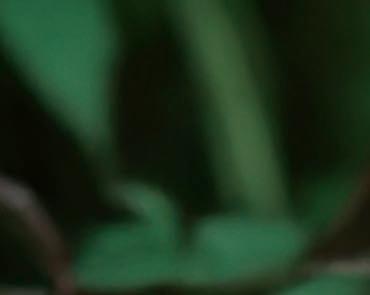





Sadly, the chance of happening across dormice or signs of their activity is become increasingly remote as their limited range continues to shrink. Numbers have plummeted 70% since 2000 – a shocking collapse in just a few decades. Climate change, abandonment of traditional woodland management practices like coppicing, and the loss of hedgerows and ancient woodland are just some of the reasons behind this precipitous decline.
Dormice are shy creatures that prefer to remain within the safety of trees. They are loathe to cross open spaces, so as their habitat retreats and fragments, populations are le increasingly isolated. This makes it harder to breed and reduces genetic diversity, weakening populations





Numbers have plummeted 70% since 2000 – a shocking collapse in just a few decades.





Other rodents such as voles and wood mice gnaw jagged holes into hazelnuts. The dormice, on the other hand, is a smooth operator, chewing out a neat, circular hole with a smooth inner rim. Look closely and you should be able to make out the tooth marks, which will be at an angle to the rim. Scratch marks may also be present around the hole.


still further. Once widely spread across much of England and Wales, today dormice are locally extinct in 20 English counties and are categorised as ‘Vulnerable’ on the IUCN Red List for Britain’s Mammals.
Ray of hope
Such a dramatic drop in numbers is disheartening, but a more hopeful future may lay ahead thanks to the

coordinated effort of many thousands of volunteers, ecologists and researchers working together through the National Dormouse Conservation Plan. Led by the People’s Trust for Endangered Species (PTES), the plan aims to support and enhance existing populations and, where suitable habitat allows, reintroduce them to areas of their former range where they are now locally extinct.
The reintroduction programme offers a chance to build resilience among the UK’s dwindling dormouse populations. Since the first reintroduction in 1993, more than 1,000 dormice have been released at 26 sites across 13 counties. The hope is that this will speed up recolonisation by this naturally slow-todisperse mammal.
Local heroes
Dormice are believed to be extinct across Leicestershire and Rutland too. Or rather, they were until this June, when over 20 dormice were released by PTES into a secret woodland location on the Bradgate Park Trust estate, creating Leicestershire’s only known population of the tiny, gold-coated mammal. The site was carefully selected with the help of LRWT, together with the Leicestershire & Rutland Mammal Group, the National Forest and Twycross Zoo. We have helped to inspect the woodland to check its suitability for dormice and will continue to offer advice and guidance to ensure it continues to be sympathetically managed.
The reintroduction builds on the success of the nearby 2023 dormouse release at the National Trust’s Calke Abbey, which saw 38 dormice return


Dormice spend much of their time either asleep, hibernating or in a state of torpor.

Dormice spend a lot of their life asleep. As well as sleeping for much of the day, they hibernate over the colder months, heading back down to ground level having spent most of the summer up in the tree branches. Dormice typically sleep out the winter among or just beneath the leaf li er found at the base of trees and hedgerows. To keep warm they curl up into a tight ball then wrap their tails around their bodies as a li le blanket.
Cold spells outside of winter or a scarcity of food can also induce a temporary state of deep sleep, or ‘torpor’, helping dormice to conserve valuable energy. Between their daily sleeps, hibernation and going into torpor, this tiny mammal can spend nearly three-quarters of the year asleep! Dormice are also known to snore, producing a highpitched squeak.



to the National Forest for the very first time. Despite that release being within the forest’s Derbyshire border, this secondary reintroduction is a vital step forward for dormouse recovery in the region. The vision is for both reintroduced populations to form part of a wider population spanning the whole of the National Forest.
Ian White, Dormouse and Training Officer at PTES is keen to create a brighter future for dormice: “PTES’ reintroductions, alongside habitat management, landscape projects and monitoring, are paramount to their long-term survival. The programme is a great step towards restoring hazel

The captive-bred dormice get a full health check before their release.

dormice to their former range, but this is only possible with the correct woodland management in place and, of course, with the help of our partners.”
The recent release site on the Bradgate Park estate should be a home-from-home for the dormice. The estate includes some of the best ancient woodland in the county, carefully managed for many years, and the team at Bradgate Park Trust are commi ed to ensuring this special habitat continues to thrive, not only for the dormice but the wide range of other rare species found there.

“This release is an exciting first step in helping dormice not only locally, but nationally too,” explains Ben Devine, Head of Nature Recovery at LRWT. “Ensuring the right landscape and habitat is in place is key to ensuring continued nature recovery, and we will continue to monitor the dormice to ensure that Leicestershire’s only known population thrives and one day expands beyond Bradgate Park estate.”
Readying for release PTES’ annual dormouse reintroductions are part of Natural England’s Species Recovery Programme. The wider partnership involves crucial work by the Common Dormouse Captive Breeders Group whose members, including Wildwood Trust, raise captivebred dormice ready for release.



The dormice then travel to Paignton Zoo, the Zoological Society of London (ZSL), and this year Twycross Zoo to undergo an eight-week quarantine period. During their stay each dormouse gets a full nose-to-tail health check by wildlife vets, ensuring only healthy dormice are released and that there is no risk of them transferring diseases or non-native parasites to other wildlife. Once they are given a clean bill of health, the dormice are carefully transported to their new woodland home to be released.





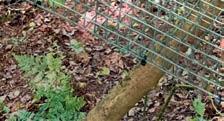
Above: Halfway house: Release cage lled with food, water and foliage. Left: Volunteers prepare food for the released dormice.
Local volunteers are instrumental in helping the dormice se le into their new home. On release day, the dormice were gently placed, in their nest boxes, into larger mesh cages filled with foliage, buds, berries, nuts and water to acclimatise to their new surroundings.

Other name: Common dormouse
Lifespan: Up to ve years
Length: 6.5-8cm (excludes tail)
Weight: 20g but can reach 35g in the run up to hibernation
and hedge areas, and the mesh cages
Volunteers then carried out daily checks and topped up their food and water. A er 10 days and a final health check, the mesh cage doors were opened to allow the dormice to explore the wider woodland. In time they will start to breed and disperse into new woodland and hedge areas, and the mesh cages will be removed. We hope to spot more signs of hazel dormice in our region over the coming years as we welcome this charming mammal home.

Habitat: Woodland and hedgerows
Diet: Nuts, seeds, berries, insects and owers
signs of hazel dormice in our region over

The vision is for reintroduced populations to form part of a wider population spanning the whole of the National Forest.


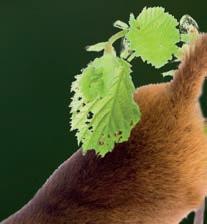







One of the biggest rewilding projects in the region is set to get underway, creating more space for nature on a truly landscape scale. This nationally signi cant project is fantastic news for the wildlife and people of South Leicestershire.


Britain is one of the most naturedepleted countries in the world, and within South Leicestershire lies some of the most heavily modified and nature-deprived areas in lowland England. Wildlife has been pushed out; today only small fragments of a once wildlife-rich landscape remain, disconnected from the natural processes essential for nature’s recovery.
But a major land purchase by Harborough District Council could be about to bring a more nature-filled future to this corner of Leicestershire. The Council has secured more than 130 acres of land at Tin House Farm to the north of Great Bowden, Market Harborough, at a cost of just under £1.8 million. Leicestershire and Rutland Wildlife Trust will now work closely with the Council on a unique vision to restore nature on this land and the countryside beyond. Working in partnership, our ambition is to create a living landscape within South Leicestershire – one teeming with wildlife
and that offers local people the chance to get closer to nature.
Our plans to reconnect and revitalise habitats will transform what is currently a featureless swathe of permanent pasture with minimal biodiversity into a healthy, vibrant and resilient environment. Wildlife will thrive once again in a network of restored habitats as we work to reestablish natural processes.
One example of this is restoring the natural course of the River Welland. The heavily modified, straightened section of the river that runs alongside the site has steep banks that offer li le in the way of quality freshwater habitat. The rewilding project opens up the possibility of reconnecting the river to its historic floodplain, allowing it to meander through the site once again. The land is also bordered by a disused railway line, which offers further opportunities to create a wildlife corridor for nature to spill
out into the surrounding countryside as it recovers.
Great Bowden Borrowpit SSSI is the only other site protected for nature close by. Plans for this newly purchased land will dramatically expand the total area of wildlife-rich habitat in the area, helping nature to become more resilient and reestablish at a landscape scale.
Work is already underway to complete baseline surveys, so we can track the progress of nature’s recovery over the coming years. With this monitoring completed the rewildling process can then get underway. We will work to restore lost habitat and create the right conditions for priority species like water voles to return to where they belong. Bringing back lost relics of the landscape such as ponds and other wetland features will go a long way to boosting the wildlife appeal of the land, while natural processes such as


Far left: Aerial view of part of the site and, inset, an AI-generated image of what it might look like after rewilding. Above: Returning lost relics of the landscape, such as ponds, will provide more homes for wildlife.
scrub regeneration will offer nesting opportunities for birds, small mammals and a range of other species. Wild flowers will sway in the breeze once more, and with them a rich mix of bees, bu erflies and other insects. The large-scale restoration of hedgerows and planting of connecting woodlands will improve the area’s climate resilience, while creating additional wildlife corridors and places for people to access high-quality natural environments.
People will be at the heart of this project and plans are afoot to ensure the site is fully accessible to the public. Restoring the land for nature will go hand in hand with our aim of bringing people closer to nature. It will give locals and visitors alike a chance to connect with nature and enjoy all the mental and physical benefits that this can bring.
By working with adjacent landowners and other key public sector partners, the aim is for this to become a major new publicly accessible green space where people can walk through the landscape on new footpaths and trails as they commune with nature.
This new land purchase is just the starting point, as Councillor Phil Knowles, Leader of Harborough District Council, explains: “Not only will we see nature restored on this land, but this project will provide a catalyst for the creation of a network of sites that will link wildlife
across the district and beyond. This will be a catalyst for a strategic partnership that will rewild large swathes of naturedepleted countryside, protecting it as public open space for generations to come and bringing nature back to the area.”
The Trust will now work in close partnership with Harborough District Council to provide a foundation for greater biodiversity and enhance the ability of species to adapt to ever-
“ is project will provide a catalyst for the creation of a network of sites that will link wildlife across the district and beyond.”
growing environmental challenges. This increased resilience will ensure wildlife can flourish in the face of climate change and other major pressures. And as wildlife grows in abundance, we will enable it to spread out into the surrounding landscape. Not only will the countryside of South Leicestershire be richer, more resilient and productive, but people and communities will benefit from being closer to wildlife.
The project also has the potential to become an example to others, demonstrating that sustainable naturalistic grazing measures can indeed support nature restoration. We want to share the benefits that nature-based
solutions can bring, showcasing effective natural flood management techniques and innovative habitat restoration techniques.
“Only through ambitious and innovative projects like this can we reverse the decline in nature and realise the benefits that it can bring,” says the Trust’s CEO Mat Carter. “This is an incredible opportunity to create a legacy that will benefit the local community long into the future.”

The rewilded land will be a precious space for both wildlife and people to enjoy.
Anyone interested in getting involved in the Market Harborough Rewilding Project can email rewildingproject @harborough.gov.uk


Temperate rainforests, which once covered a fi h of the UK but now cover less than one per cent, contain one of the oldest plants in the kingdom – moss. These prehistoric plants have been around since before the dinosaurs. They are phenomenal and need their moment to shine. So why not give your garden the temperate woodland makeover with moss, ferns and lichens.
You may already have moss in your garden in the damp, shady environments. These mossy habitats are sacred and need time to be le alone to grow. Sadly, o en people don't see moss as a plant in the garden, they see it as a problem that needs to be scraped off. We absolutely have to stand up for these ancient mossy places or they will be lost.
Moss is an essential part of any garden ecosystem where fungi grows and a host of small creatures find shelter and food. Beetles, slugs and snails to tiny springtails and microscopic creatures a ract birds and other animals higher up the food chain.
Zoe Claymore, the award-winning garden designer behind The Wildlife Trusts' British Rainforest Garden at the RHS Chelsea Flower Show, connects us to moistureloving plants in our gardens from our Celtic past.
I spent my childhood playing on mossy boulders over the River Lyd, in a temperate woodland in Lydford Gorge out the back of my grandparents’ house. I firmly believe moss is a great addition to any garden: when I feel the so , velvety cushion under foot or in my hands, I still have that childlike sense of wonder.
In my British Rainforest Garden, I use a leaning silver birch tree and hazel tree to create a British rainforest vibe, whilst water trickles over natural stone boulders to evoke the sounds of the forest. Garden-friendly adaptations include an accessible wooden walkway through the wonderland, and a living wall covered in ivy, ferns, woodland flowers –and moss, of course!




Zoe Claymore is an award-winning landscape and garden designer based in southwest London. In 2023 she won RHS Gold, People’s Choice, and Best ‘Get Started’ Garden at Hampton Court for her design of The Wildlife Trusts': Renters’ Retreat



The charismatic, tall pink flowers of the foxglove are a reminder of the hazy days of summer, buzzing with bumblebees and moths.

Ferns
Have fun with ferns and throw them some shade in the garden so those lush, curly fronds can thrive. This is the purple royal fern.

Hazel
Hazel trees are good in the city for smaller gardens, great for wildlife and can be coppiced to use as stakes in the garden.

Hypnum cupressiforme moss
This is great moss for lawns and very ecologically adaptable.

The British Rainforest Garden at RHS Chelsea Flower Show was made possible with generous sponsorship from Project Giving Back and our British Rainforest partner Aviva. Following the show, the garden is being relocated to Bristol Zoo.

Black spot lichen
Lichens are epiphytes or ‘air plants’ that survive on nutrients and moisture in the air. They are made of fungus and algae, ‘rock up’ on trees and take time to grow.

Dicranum scoparium moss
This gorgeous moss is great for adding patches to the lawn. It's amazing under foot, so so and spongy and easy to maintain.

Silver birch
Silver birch trees o en don't grow straight in these habitats, so to celebrate nature’s resilience, I’ve included a leaning tree. Embrace the imperfect, don't get rid of it.

Oak moss lichen
Lichen takes time to grow on the bark of a tree, thriving on sunlight and moisture. There are many different types of lichen that spread slowly with wonderful names from oak moss to shaggy strap and handwriting lichen.


This walk along green paths, with two hides to sit in, can easily be completed in an hour, making peaceful Kelham Bridge an ideal ‘drop in’ reserve to unwind in and reconnect with nature.

The deeper water o ers a chance of seeing more unusual species like Jack snipe and water rail.

Kelham Bridge is a fantastic site for warblers and many other birds. In fact, the reserve’s bird list currently stands at 134, a figure that includes many migrant species as the Sence Valley seems to have a magnetic draw on the birds passing through the area.
The mature hedgerow 1 that flanks the first section of path is always worth checking. The sympathetically managed hedgelines are great for autumn wildlife. Hawthorn, elder, blackthorn and hazel produce a steady supply of fruits and nuts for sustenance, while the ivy offers a late nectar source for insects like bees. Keep an eye out for the arrival of fieldfare and redwing. The neighbouring ne le fields and the patches throughout the reserve support a wide range of wildlife from insects to birds.


A viewing area in the mature hedgerow overlooks a reedbed and a floodplain beyond in the pumping station field This scene used to be very

different, as the field was once a sea of ne les and willowherb. The growth of this vegetation was fuelled by the nutrient-enriched soil, which was a legacy of the site’s previous life as a sewage treatment plant. This area was transformed by removing the topsoil and installing the two Phagmites reedbeds, complete with level control facilities. Please view only from the permissive path to avoid disturbing wildlife.

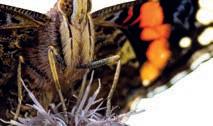

including




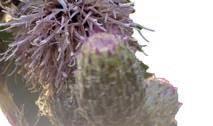
As the path opens out beyond the mature hedgerow a more varied ground flora can be found 3 . You might find red campion and meadowsweet still in bloom. In total, 24 species of bu erfly have now been seen at Kelham Bridge. Keep your eyes peeled for late flyers basking in sunny spots, including peacock, painted lady and red admiral bu erflies. You might even see small, seed-eating birds enjoying the numerous seeds that ne les produce.
the numerous seeds that ne

Take the path to the right to access the first of the reserve’s two hides 4 . This hide gives excellent views of a wader scrape with ample expanses of mud aimed at tempting passing birds during the autumn migration period. Green sandpiper is the most likely species to be seen here. One or two birds usually winter in this section of the Sence Valley and numbers can enter double figures in late summer as birds return from their Arctic breeding grounds. Snipe are also a racted to the exposed muddy banks. You also have views of the artificial sand martin wall, which is used during the summer, though you might just catch the last hirundines of the year feeding over the ponds before heading south.

resident flock of wigeon, gadwall and teal can be found. Scouring the reedbed edges can produce more unusual species such as water rail and Jack snipe. Kingfishers are another regular.
Bats are still active during the earlier weeks of autumn. They use this time to build up fat reserves ahead of hibernation. At dusk, soprano pipistrelle and Daubenton’s bats hunt for insects emerging from the water or from the vegetation around the scrapes.



Reedbed specialists are o en active in autumn.








The second hide 5 offers quite a different perspective over deeper water surrounded by a variety of emergent vegetation. In winter various wildfowl make this area their home, when a small
The Phragmites reedbed 6 at the eastern end of the main pond is home to a number of reed and sedge warbler pairs, which you might encounter before they leave. Dispersing marsh harriers will move through, as might bi erns, and listen out for the ‘ping!’ of a bearded tit. Late-flying dragonfly species, such as common and ruddy darters and migrant hawkers can be seen around the pond margins or flying about as they feed on tiny insects that they catch in flight.
The ideal vantage point to view the entire site, as well as the countryside beyond, is from the benches located in Hills and Hollows Field 7 , which can be accessed from the Forestry Commission track. Look out for kestrels and barn owls hunting over the rougher areas. Jays and green and great spo ed woodpeckers are resident year-round. Other winter arrivals include redpolls and siskin, which love feeding on alders.
This small section of the Sence Valley has seen some dramatic changes over the last century. Hopefully the next 100
the last century. Hopefully the next 100 years will be much more


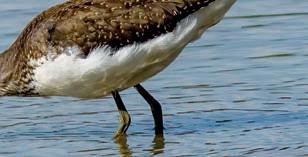


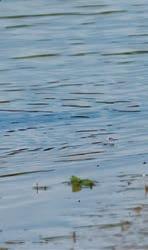


stable and of great value to the county’s wildlife, all enjoyed and carefully documented by numerous Leicestershire and Rutland Wildlife Trust observers.
Kelham Bridge lies 2km north of Ibstock and is accessed directly from the A447.
Nearest postcode: LE67 2AN Map ref: SK 405 120 what3words: couch.slopes.wardrobe Parking: Limited parking on the wide verge immediately south of the entrance, but please don’t block the gates as Severn Trent Water requires 24hour access to their pumping station. Size: 8ha
For further informationn, please see our Nature Reserve Guide or visit lrwt.org.uk/nature-reserves


Joanna Foat shares why she believes we should all have a nature notebook to aid in our efforts to protect wildlife.
Many renowned botanists, like Ellen Hutchins – Ireland’s first female botanist – began their passion for nature with a simple notebook. Hutchins famously spent five days admiring a piece of seaweed, carefully preserving fragments and sketching her ‘li le beauties’ of mosses and lichens. The eminent Francis Rose’s field notebooks are all we have as records for some of the rarest of British lichens historically.
Early records of flora and fauna like these in notebooks across the UK have laid the groundwork for The Wildlife Trusts in protecting nature reserves since 1912. As we face the dual nature and climate crises, collecting data on wildlife is more critical than ever. These precious sightings not only inform conservation projects but also, eventually, government policies.





























Nigel Doar, Head of Research at The Wildlife Trusts, highlights the need to engage more people of all ages in recording wildlife. Not everyone, he notes, starts with a vast knowledge of species.
“We can worry too much about what something is, when just taking notice and enjoying the beauty in nature can spark interest.”
He recalls his own challenges as a student identifying an oak tree in a hedgerow, a process akin to spot-the-difference. Conservationists use a classification system of taxonomic units – essentially the identification of shared characteristics – to help them work out the species



























































or family of species of a particular plant or animal.


Nigel shared that his teacher said a ‘difference’ is what I call a recognisable taxonomic unit, and that “sometimes that is just enough when you are starting out”












































Mike Waite, director of research and monitoring at Surrey Wildlife Trust, sees first hand how curiosity leads people from casual observation to structured surveys and contributions to science.
“Many people move from noting birds on their feeders to eventually learning bird song. Online tutorials offer training, and soon they’re taking part in national breeding bird surveys. That’s how I started.”
Nowadays, he advises the local council on its nature recovery strategy, priority species list and measuring progress towards restoring 30 per cent of land by 2030.


He notes that although some citizen scientists may be naturally introverted or solitary, their observations on rapidly advancing species like dragonflies –




as indicators of climate change – are invaluable. “Many new dragonfly species have colonised the UK from the continent over the past decade, providing clear data on environmental shi s.”
The Wildlife Trusts across the country offer citizen science programmes where volunteers learn identification skills and can contribute to conservation surveillance data. Projects include Shoresearch, Seasearch, Riversearch and Nature Counts for species monitoring to name just a few.




Thousands of people are ge ing involved walking transects to count the number of bu erflies, mapping the distribution of hedgehogs across a city, or reporting field signs of o ers along river banks. This data directly supports species conservation and habitat restoration, local strategies for nature recovery and is vitally needed to lobby government to protect nature.
What could be more rewarding than spending your weekend immersed in nature? This hands-on connection not only deepens personal engagement but also contributes to science. So, pick up a notebook, jot down your observations, and begin your journey as a citizen scientist. You never know where your notes might lead.

Find out more about how you can take part in citizen science at: wildlifetrusts.org/citizen-science




Waxcaps are probably the most well-known of the grassland fungi. Their fruiting bodies are o en moist or slimy and come in an array of colours, reflected by their equally colourful names: parrot waxcap, spangle waxcap, golden waxcap, coral fungi, olive earthtongue or honey waxcap, for example.
Waxcaps are key indicators of semi-natural, unimproved grasslands, a habitat that has become seriously threatened throughout the UK and Europe, with a loss of more than 90% in the last 75 years.
Most waxcaps grow in nutrientpoor grasslands, such as those found

in old churchyards and cemeteries. They can also be found on several of our nature reserves.
It can take many hundreds of thousands of years for waxcaps to establish in grassland and ancient pasture. Any cultivation of these unfertilised grasslands will damage or even destroy the underground networks or ‘mycelia’ of waxcap fungi. But mowing and removal of cut grass is essential to maintain ideal conditions for waxcaps.

The UK’s old grasslands are among the most important sites in the world for waxcap grassland fungi.
Waxcaps appear throughout autumn. Make repeat visits to our recommended sites between October and the first frosts to see different colourful waxcaps.








Search the grassland for some of the 17 species of waxcap recorded here, including meadow waxcap 1 , a larger fungus of brown/orange colour fading to bu , which is easily spotted, sometimes in large rings. Heath waxcap 2 is tall and thin with a green-orange colour and slimy caps that when crushed smell of burnt rubber. The cedarwood waxcap 3 is very similar and, as its name implies, has a pleasant cedarwood smell. Also of note is the pink waxcap (opposite), often called ballerina waxcap because of its frilled, tutu-style edges that curve upwards with age.

Where: Copt Oak, LE67 4UX









This is a site of national signi cance for waxcaps, with 17 species recorded here! These include orange and honey waxcaps, recorded for the rst time in Rutland. Honey waxcap 4 is orange-coloured with a frilled edge to the cap and smells of honey as it dries, while orange waxcap, often seen in clusters, has bright orange-red caps that fade to yellow. Crimson waxcap 5 is another scarce species found here. It has blood-red convex caps on yellow-orange stems. Can you help us record a full 19 species to make Merry’s Meadow an internationally signi cant site for waxcaps? Join us there for a special fungal foray on 19 October. See page 35 for more details.
Where: Greetham, LE15 7RJ


Many cemeteries and churchyards are well-known waxcap hotspots, including Whitwick Cemetery in Coalville (LE67 5DL) where 14 species of waxcaps were recorded in 2024, including cedar waxcaps. Ibstock Cemetery (LE67 6LP) hosts at least 13 species such as pink waxcaps and yellow foot waxcaps, while 13 species have also been found at Loughborough Old Cemetery (LE11 2AF), including scarlet waxcaps, cedar waxcaps and crimson waxcaps. See them for yourself
The ancient grasslands of this medieval deer park o er ideal conditions for waxcaps and rare coral fungi. Meadow coral 6 is a diminutive goldenyellow fungus that rises with branching stems from a common thickened base. Each branch splits into two or three blunt tips, resembling the underwater coral after which it’s named. Beige coral has a similar form and although less colourful is just as rare. Scarlet waxcaps 7 are often seen in ‘troops’ that are more widespread than clusters, with their red caps glistening above red or orange stems. Then there’s the very slimy, bright green parrot waxcap 8 , which turns yellow with age. This common fungus also comes in purple and brick-red colours.
Where: Newtown Linford, LE6 0HB (main car park)


Ash Tree Farm includes areas of owering grasses and wild owers that create an awestriking display.


Diligent, decades-long management of privately owned land has created a wonderfully wild place that will shape the future of South Leicestershire’s natural landscape, as Wendy Tobitt reports.
The sound of insects buzzing and whirring among the flowering grasses and wild flowers is almost deafening as Ben Devine, Head of Nature Recovery, strolls through one of the meadows at Ash Tree Farm in Bi eswell.
Ben is here with landowner Michael Coates to walk over his 35-acre corner of southern Leicestershire and discuss their latest plans. This is an exciting time for the Trust as we work with Michael

to continue and develop his vision for nature. Michael and his family have chosen to leave this land in our care, as a future legacy gi in their will. The land will continue to be managed as a special place for nature to recover and for people to reconnect with nature.
“From our initial surveys we know that Michael has been looking a er Ash Tree Farm exceptionally well to help nature return to land that would likely have been intensively farmed,” explains Ben. “It really is an extraordinary place for wildlife, and we don’t yet have the full picture of all the insects, amphibians, birds and mammals that live here.”
Michael’s family moved to Bi eswell 44 years ago, gradually buying up fields to make spaces and places for wildlife. Woodlands were planted, ponds dug, and wildflower seeds sown on some of the old pastures where ca le and horses had grazed. Over the years, nature reclaimed the farmland, almost by accident to begin with and then by design.
Michael has welcomed nature in – such as this swollen-thighed beetle on a buttercup.

“Michael has told me about the joy he and his family have had, watching how much has changed as the woodlands matured and the wildflowers took over the meadows to let nature in,” says Ben. The ancient ridge and furrow field pa ern dating back 500 years or more to Tudor times shows that this land was once farmed with oxen and horse
Last November we surveyed the fungi at Ash Tree Farm and discovered a phenomenal number of grassland species, including some rarities. On one visit we recorded 13 species of waxcap, which would constitute a site of national signi cance for this type of mushroom. It makes this one of the most diverse waxcap grasslands surveyed in our two counties over the last year.
The most notable species recorded is pink waxcap, often known as the ballerina waxcap because its pink cap ares out and splits like a tutu. This nationally scarce waxcap is classi ed as vulnerable on the IUCN Red List. The UK remains its stronghold with half of all known European sites for this species found here.
Earthy waxcap and toasted waxcap are also scarce in Leicestershire and Rutland. Finding them at Ash Tree Farm marks only the sixth county record for these species.
“It really is an extraordinary place for wildlife, and we don't yet have the full picture”
ploughs but has avoided disturbance from modern agricultural machinery.
“Ash Tree Farm is inspirational for us,” says Ben. “It’s the catalyst for wider landscape-scale nature recovery in South Leicestershire and will be invaluable in demonstrating to landowners and farmers how much can be achieved by relaxing the way land is managed, to let nature reclaim it.”
Exciting as this is for the Trust, we will be taking a watchful approach to our work at Ash Tree Farm, as Ben explains. “One of the brilliant aspects of Ash Tree Farm is that Michael let nature come back at its own pace, and that’s what we will continue to do. The next few years will be an observational period as we watch, study, record and learn about the wildlife here, and what could be changed to a ract even more. It will be a time for us to get to know the land and its diverse habitats.”

Above: Pink or ballerina waxcap; Right: Both species of earthtongue were found at
fungi, but if lots of people walked over these rare grasslands they could be damaged,” says Ben. “We will find ways of showcasing these unusual waxcap and earthtongue fungi so more people can appreciate their beauty.”
Michael’s passion for nature at Ash Tree Farm is infectious. He’s recruited visitors to join the Trust and even encouraged contractors working on the woodland to make donations.

Like waxcaps, earthtongues are an excellent indicator of old, unfertilised grasslands. Earthtongues are uncommon in our counties - just four species have been recorded here. Incredibly, two of the species were found at Ash Tree Farm.
Michael is keen to welcome more people to visit the land here at his family home at Ash Tree Farm by private appointment, and the Trust will continue to facilitate this with care, to make sure we protect the tranquillity that has enabled wildlife to make its home here.
“There’s increased pressure on nature reserves when too many people visit and important fragile habitats can suffer. The site has some extraordinary grassland
“It’s been really inspiring working closely with Michael and his family on the Ash Tree Farm legacy project over the last two years,” says Ben.
“It’s hard to imagine the site as it was 40-odd years ago, with limited areas for wildlife. What we see today is a transformed landscape: rich in flowering plants, fungi, insects, birds and mammals, and a place where you can immerse yourself in nature in an otherwise nature-depleted region of the county. Ash Tree Farm will serve as a legacy for the people of South Leicestershire for generations to come and we are eternally grateful for this generous gi .”
For more information on Ash Tree Farm or to find out how you can leave your own legacy for nature in your will please call 0116 262 9968 or email info@lrwt.org.uk




Lbirch































ike so many wild encounters, it came down to timing, research and a li le bit of luck. I knew I was in the right place – patrolling a patch of grass, shrubs and saplings beneath towering birch trees. I knew it was the right season, with the late spring sun warming the morning.

But I’d been here before and le disappointed. How could I hope to spot one li le beetle in a forest of foliage?












But there she was, a splash of red amongst the green. Hunkered on a leaf, soaking in the sunlight, warming up for her maiden flight. A female hazel pot beetle. She was almost cartoonishly oblong, a caricature of a beetle with her black head tucked beneath her bright red body. I’m not sure if it was her shape, her colour or her rarity that enchanted me, but that encounter will live long in my memory. I’ve enjoyed similarly magical moments with many more beetles, from dazzling jewel beetles to cliff tiger beetles racing across rocks. The sheer number and variety of beetles in the UK is staggering – there are more than 4,000 of them. Wherever you look, however long you search, there will always be a new beetle to discover. They’re even more diverse than The Beatles’ back catalogue and, I think, should be just as celebrated. It’s time for a new Beetlemania!
















































Tom Hibbert is a naturalist and content officer for The Wildlife Trusts. He’s currently on a quest to track down all of the UK’s tiger beetles.









































If the nation had a favourite beetle, it would probably be a ladybird. They’re familiar, brightly coloured and considered the gardener’s friend, thanks to their appetite for aphids. When you picture a ladybird, it’s likely the 7-spot, with seven black dots decorating its bright red back. But did you know there are almost 50 species to discover in the UK?









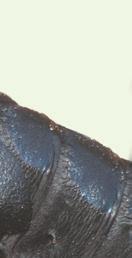

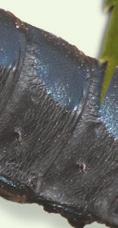






















Many of them share a similar style, pairing red and black. Others can be orange or yellow. These bright colours are a warning. They let potential predators know that this meal would leave a bad taste in the mouth. This is known as aposematic colouration. Studies have shown that brighter ladybirds tend to be more toxic, with birds less likely to a ack the brighter species as a result.

















(relatively) impressive length of 8.5 mm. It’s a conifer yellow beetle, with rectangular black spots that o en

The largest ladybird is the eyed ladybird, reaching a (relatively) impressive length of 8.5 mm. It’s a conifer specialist, best looked for on the branches of Scots pine. Whilst many ladybirds are found in trees, there are plenty to be discovered closer to the ground. The 14-spot ladybird stalks aphids across ne les and other low-growing plants. It’s a beautiful, bright yellow beetle, with rectangular black spots that o en fuse together.







Not all ladybirds are large and brightly coloured.

Not all ladybirds are large and brightly coloured. Almost half of our resident species are considered inconspicuous ladybirds. They’re small, subtly marked and much more difficult to find. The aptly named dot ladybird can be as li le as 1.3 mm. It’s a black speck o en found on fruit trees, where it hunts spider mites – helping to control their numbers.

dot ladybird can be as li le as 1.3 mm. It’s a black numbers.
Clockwise from bottom left: bloody nose beetle, 7-spot ladybird, red-headed cardinal beetle, soldier beetle, dock leaf beetle, oak jewel beetle, rosemary beetle, devil’s coach-horse, stag beetle, thick-legged flower beetle, black oil beetle.








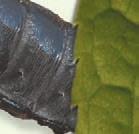














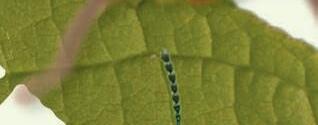





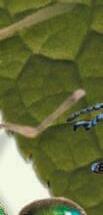





















































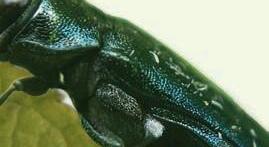









Insect enthusiast


Tom Hibbert delves into the best of the beetles.



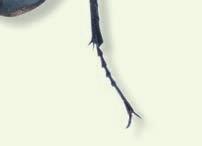

















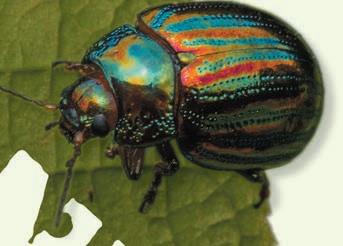







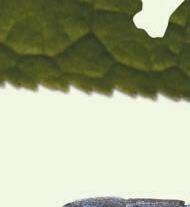








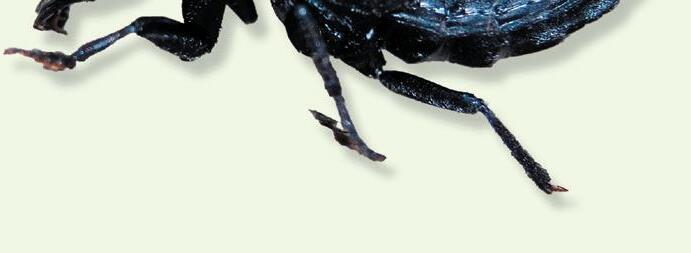























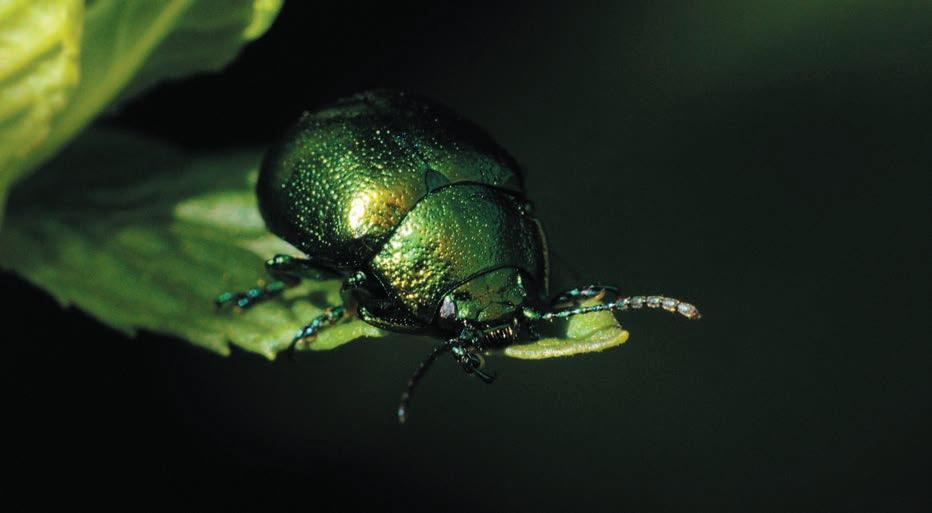






Let it bee
Imitation is the greatest form of fla ery, but it can also be an excellent survival strategy. Lots of defenceless insects have evolved to look like bees and wasps to fool predators. This is known as Batesian mimicry and there are some brilliant beetles ge ing in on the act.
One of my favourites is the bee beetle. It has black bands across its yellow wing cases, bringing to mind a bee’s bum. The effect is enhanced by a fuzzy ginger back and a habit of trundling across flowers. But as any good cover band knows, it’s not enough to look like your idol, you have to sound like them too. Bee beetles buzz as they fly from flower to flower. Sadly, you’re unlikely to see one away from Wales or the Highlands of Scotland.




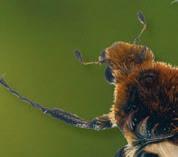







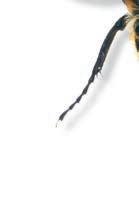


The sheer number and variety of beetles in the UK is staggering – there are more than 4,000 of them.




Luckily, there’s another mimic found a lot more widely. The wasp beetle lives in woodlands across most of Britain. Yellow bands across its black body give the impression of a wasp. The beetle adds to this effect by moving in a jerky, wasp-like manner. You can o en find wasp beetles resting openly on leaves or fences, trusting their colours to keep them safe.






















Did you know?

Rutland Water is home to Europe’s smallest and Britain’s largest beetles. Both are recent discoveries!








Hey jewel

7-spot ladybirds are a familiar sight in parks and gardens.

Beetles benefit from wilder gardens! Download our free guide to bring the best beetles to your patch
wtru.st/Beetles





How do you take a beetle and make it be er? You make it shiny! From shining stripes to metallic sheens, there are some gloriously glossy beetles in the UK.










Jewel beetles live up to their name, with some species shimmering emerald or bronze. But, like true precious gems, they’re hard to come by. Their larvae leave characteristic D-shaped holes in the trunks of trees, but it takes a lot of luck to spot an adult. Fortunately, there are plenty of shining beetles that are far more easily found.


For example, rose chafers. These big beetles are hard to miss, visiting flowers on a sunny day. They’re a gorgeous, metallic golden-green, their colours shi ing as the sun catches them. Like many beetles, they are pollinators, fulfilling the same important role as bees and bu erflies. Rose chafers are found throughout southern Britain, sometimes visiting gardens.

striking purple stripes. It’s a recent arrival to the UK



Another gli ering garden visitor is the rosemary beetle. Its metallic green back is embellished with striking purple stripes. It’s a recent arrival to the UK but has quickly spread. These beetles are easily found on rosemary and other aromatic plants. They are leaf beetles and share the genus Chrysolina with many equally a ractive species, including the mint leaf beetle and dead-ne le leaf beetle.
from the bright and



beetle and dead-ne le

Let’s shake it up from the bright and bold and explore some of our more bizarre beetles. When it comes to looks, weevils have the best nose in the business – though technically it’s a rostrum with their mouthparts at the end. This long ‘snout’ gives them a comical appearance, which is only enhanced by their large and o en prominent eyes.


One of the longest snouts belongs to the acorn weevil. Females use theirs to bore into an acorn, allowing them to lay an egg inside. The young weevil grows inside the acorn, eventually burrowing out to pupate in the soil. Not all weevils have such a long snout. The scarce fungus weevil’s rostrum is broad and fla ened. It feeds on the fungi known as King Alfred’s cakes, its mo led pa ern providing the perfect camouflage.
Whether they’re strangely shaped, shiny, brightly coloured or masterful mimics, beetles are brilliant. They are pollinators, predators and recyclers, carrying out the vital tasks that help keep wild places balanced. Let’s come together and celebrate these incredible insects.

Humanity’s demands today for nature’s goods and services far exceed her ability to meet them on a sustainable basis. We need 1.7 Earths to maintain the world’s current living standards, and that’s a conservative estimate. But we would not know that by studying the measure most widely used to judge economic success: Gross Domestic Product (GDP).
That’s because GDP does not consider the depreciation of assets, such as wetlands, mangroves, coral reefs, grasslands and forests, that accompany our production and consumption activities. An economy could be enjoying GDP growth for a long while even as the basis on which we produce and consume degrades and shrinks.
The human overreach is reflected in the rate at which species are becoming extinct, currently at some 100-1,000 times the rate of extinction over the past several million years. But when we think of human-induced species extinction, large-scale changes in land use come to mind.
We tend to think of forests being transformed into land for crops, animal farms and plantations; of grasslands transformed into pastures; and of mines and quarries ripping apart dense jungles. But there is a more insidious process at work, which is perhaps as powerful: the bit-by-bit fragmentation of ecosystems that accompanies GDP growth.
Persistent, incremental encroachment into nature is insidious because each move seems near harmless: a new bus lane cu ing through an ancient orchard here, a mangrove forest sliced to make way for a luxury hotel there, a bat habitat destroyed to make room for additional housing in an urban sprawl


elsewhere. The problem is, the orchard will not return, the mangrove forest won’t have space to recover its previous glory and the bat population will die because it has nowhere to go.
If at each move human demand is allowed to trump ecological integrity, the landscape that evolves becomes denuded of wildlife. It is there that we each can play a role by minding our own neighbourhood. Unlike global climate change, over which no group on its own can have a marked effect, biodiversity can be protected by communitarian endeavours. Our Wildlife Trusts play an enormous role in protecting and preserving local wildlife. Projects like the Wildlife Trust for Bedfordshire, Cambridgeshire and Northamptonshire’s acquisition and preservation of Strawberry Hill, a rewilded farm in Bedfordshire, are helping to expand space for wildlife in some of the most naturedepleted areas of the UK. And on a different scale, the same Trust, of which I’m proud to be President, is working with young people in Luton to plant hedgerows in local parks that connect woodlands and other habitats together. This allows wildlife to thrive in the most urban of environments and simultaneously ensures that the local residents are connected to the wildlife that shares their neighbourhood, too. Wildlife Trusts all over the country have similar projects and together we are making a difference.
Done right, nature makes every development high-quality, attractive and sustainable. Co-sign our open letter, calling for new developments to work in harmony with nature.
wtru.st/planning-bill
Wildlife Trusts’ Chief
met Professor Dasgupta to discuss the findings of the globally respected review on The Economics of Biodiversity You can catch up on the recording of our WildLIVE on The Wildlife Trusts’ YouTube channel by visiting wtru.st/Economicsof-Biodiversity
Sir Partha Dasgupta is a globally respected environmental economist and professor at Cambridge University, author of a groundbreaking report on protecting global nature and president of the Wildlife Trust for Bedfordshire, Cambridgeshire and Northamptonshire.


We look forward to meeting you and celebrating our work over the past year.
This year’s Members’ Day will be held on Saturday 22nd November at the Trinity Methodist Church on Royland Road, Loughborough. This is a wonderful venue with plenty of free parking close by.
Starting in mid-morning, we’ll hear from our guest speaker Dr Rob Stoneman, Director of Landscape Recovery at The Wildlife Trusts, while LRWT staff will tell us about recent developments in the Trust’s work.
The day will include the Trust’s Annual General Meeting (AGM), which as usual will cover the Annual Report of the Trustees, and the Honorary Treasurer’s report on the financial statements. This year there will also be a short Extraordinary General Meeting (EGM) which will take place immediately before the AGM. At the EGM we will be asking
the membership to approve a new set of Articles of Association for the Trust.
All details of the AGM and EGM and the supporting papers will be circulated from the end of October.
As well as brief refreshments in the morning, we will provide sandwiches and snacks at lunchtime. This will give members, staff and Trustees more time to mingle and talk, as well as a chance to catch up on the details of our current work, which will be set out on display tables around the venue. The event will finish around mid-a ernoon.
For those unable to a end in person, the meeting will be streamed online. It won’t be possible to vote online, but members who can’t be there will be able to vote by proxy.
Please see the separate formal invitation le er which accompanies this issue of Wild. Proxy forms and all relevant
documents will be available to download prior to the event. If you do not have access to the internet, the le er tells you how to obtain these. The le er also sets out your options for receiving this year’s Annual Review.
Trustees and staff thoroughly enjoyed meeting members at last year’s Members’ Day, and we very much hope that you will be able to join us, either in person or online, on 22nd November.
Don’t delay! This is expected to be a very popular event and as spaces are limited, please be sure to book early!
Our full events programme can be found online. Check there for further details, including how to book, prices, times, and venue. Anyone booked on an event or volunteering activity will be notified of any changes. New events are constantly being added, so please check regularly for the latest updates: lrwt.org.uk/events
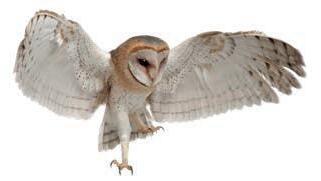
Cossington Meadows
Weds 3 Sept, 7.30-9.30pm
Barn Owl Walk
Wild Walk led by Chris Hill to search for barn owls as they head out to hunt. £15pp.
Lyndon Nature Reserve: Lyndon Visitor Centre
Weds 3 Sept, 7-9pm
Evening Bat Walk
Join us for our bat walk at Lyndon. We will use bat detectors to search for some of the main species found here. £15pp.

Rutland Water Nature Reserve: Anglian Water Birdwatching Centre Fri 5 Sept, 9.30am – 12.30pm
Guided Walk with Je
Whatever your experience of nature reserves, come along for a morning stroll with Jeff to discover some amazing wildlife. £10pp (£5 for annual permit holders).
Charnwood Local Group
Weds 10 Sept, 7.30pm
The Making of Springwatch
Jack Baddams, Springwatch cameraman and naturalist, tells us about his role on one of the UK’s most beloved nature programmes.
Halstead Hill Farm
Fri 12 Sept, 10am – 12pm
Agroforestry and Natural Heritage Farming
Don’t miss this special event where you will learn about agroforestry and natural heritage deep in the beautiful Leicestershire countryside.
£12pp.
Lyndon Nature Reserve:
Lyndon Visitor Centre
Fri 12 Sept, 7-9pm
Evening Bat Walk
Rutland Water Nature Reserve: Anglian Water
Birdwatching Centre
Fri 19 Sept, 9.30am – 12.30pm
Guided Walk with Je
See 5th September for details.
Rutland Water Nature Reserve: Volunteer Training Centre
Sat 20 and Sun 21 Sept, 9.30am – 4pm
Dry Stone Walling
Learn the basic principles of the craft of dry stone wall building. £99pp.
Rutland Water Nature Reserve: Anglian Water
Birdwatching Centre
Fri 26 Sept, 9.30am – 12.30pm
Terry’s Friday Birdwatching
Walks
Enjoy a three-hour guided walk led by Terry Mitcham, bird recorder of the Rutland Natural History Society and a very experienced birdwatcher. £10pp (£5 annual permit holders).
Rutland Water Nature Reserve: Volunteer Training Centre
Sat 27 Sept, 10am - 12.30pm
Fungi Foray
Rutland Water Nature Reserve: Anglian Water Birdwatching Centre Fri 10 Oct, 9.30am – 12.30pm
Guided Walk with Je See 5th September for details.
Rutland Water Nature Reserve: Volunteer Training Centre Sat 11 and Sun 12 Oct, 9.30am – 4pm
Hedgelaying for Beginners Learn the art of hedgelaying, practise hands-on, and lay your own section of hedge. £99pp.
Melton Mowbray Local Group Mon 13 Oct, 7pm Tree Identi cation and Care Stewart Marshall hosts a talk on how to ID trees and how to look after them.
Great Bowden Local Group Weds 15 Oct, 7.30pm Greener Golf Network Illustrated talk on the Greener Golf Network and how it is growing.
Rutland Water Nature Reserve: Anglian Water Birdwatching Centre Fri 17 Oct, 9.30am – 12.30pm Terry’s Friday Birdwatching Walks

See 3rd September for details.

Rutland
Local Group

Sun 14 Sept, 10-11.30am
50 Years of Wetland Birds
Celebrate 50 years of wetland bird surveys at Rutland Water. Join our expert Prof. Tim Sexton to learn about this important work and what has changed during that time. £5pp.
Great Bowden
Local Group
Weds 17 Sept, 7.30-9pm
Market Harborough
Rewilding Project
Our species expert, Tim will take you to the places where spectacular fungi can be found. Expect to be wowed and see the fungi that aren’t always seen! £12pp (£3 children).
Charnwood Lodge Sat 4 Oct, 10am – 12pm Fungi Foray

Hear the latest update from LRWT’s nature recovery team on the remarkable rewilding project near Market Harborough.

Lyndon Nature Reserve:
Lyndon Visitor Centre
Weds 17 Sept, 7-9pm
Evening Bat Walk
See 3rd September for details.
Meet at Bomb Rocks for a fungal foray to celebrate National Fungi Day. £15pp (£5 children).
Charnwood Local Group
Weds 8 Oct, 7.30pm
The Greening of Golf
The Greener Golf Group updates on how this important wildlife network is expanding.
Wildlife Book Club
See 26th September for details.
Holwell Reserves Fri 17 Oct, 5.45pm Bat Walk
Celebrate Bat Week with a dusk walk around the reserve to see which bats are about. Bat detectors supplied. £15pp.
North West Local Group Fri 17 Oct, 7pm
Birds of the National Forest Exploratory talk on the quest for distinctive photographs of birds in the National Forest.

1st Weds of the month, 10.30-11.30am
Rutland Water Nature Reserve





Love reading and wildlife? Come along to the Trust’s Wildlife Book Club! We discuss two books every month covering topics from specific species to landscape or environmental themes. It’s free to join and all are welcome. Email for more details: volunteering@lrwt.org.uk





Launde Park Wood Sat 18 Oct, 10am – 12pm
Fungi Foray
Get up close to fabulous fungi on an autumnal amble in one of Launde Park’s beautiful woodlands. £15pp.
Merry’s Meadow Sun 19 Oct, 10am12.30pm
Waxcap Wonderland
Search for rainbow-bright waxcap fungi on one of the finest grasslands in Leicestershire. £15pp.
Rutland Local Group Mon 20 Oct, 7.30pm
Journey to the Third Kingdom
Illustrator and naturalist Kate Fortune-Jones describes some of her field work, identification of fungi and the inspirations and processes of her artwork
Prior’s Coppice Fri 31 Oct, 3-4.30pm Wildlife at Dusk
Explore the nature reserve as the sun goes down. Listen out for owls and bats and see things from a different perspective. £15pp.
Cloud Wood Sun 2 Nov, 10am –12.30pm
Coppicing Members Event
Learn about the coppicing regime at the reserve and how it benefits wildlife then have a go at some ride-side coppicing. Optional donation to the Trust.
Rutland Water Nature Reserve: Volunteer Training Centre Sat 8 and Sun 9 Nov, 9.30am – 4pm Hedgelaying for Beginners
See 11th October for details.
Melton Mowbray Local Group
Mon 10 Nov, 7pm Peppermint Billy
A local historian will tell the tale of this Melton character from the 19th century.
Keep watch for our autumn/winter Rutland Water events programme, including popular otter and badger watches and additional reserve walks at lrwt.org.uk/events
Rutland Water Nature Reserve: Anglian Water
Birdwatching Centre
Sat 15 Nov, 9.30am – 4pm
Wildfowl and Wader Day
This full day with Terry Mitcham is a fantastic chance to admire the variety of wildfowl passing through Rutland or arriving for winter. £15pp (£10 for annual permit holders).
Rutland Local Group Mon 17 Nov, 7.30pm
Nature Recovery in Action
Explore nature recovery projects underway across Leicestershire and Rutland, from restoring wildflower meadows to rewetting wetlands.
Great Bowden Local Group
Weds 19 Nov, 7.30pm
Birds of Northampton
Presentation by long-standing volunteer Jonathan Cook, including bird surveys to support conservation projects.
Rutland Water Nature Reserve: Anglian Water

Rutland Water Nature Reserve: Anglian Water Birdwatching Centre Fri 14 Nov, 9.30am – 12.30pm
Guided Walk with Je
See 5th September for details.
Birdwatching Centre Fri 21 Nov, 9.30am – 12.30pm Terry’s Friday Birdwatching Walks
See 26th September for details.
North West Local Group Fri 21 Nov, 7pm
Species Recording in Willesley Wood
Discover the incredible fungi, flowers, galls, mosses and insects recorded in Willesley Wood.
Rutland Water Nature Reserve: Anglian Water
Birdwatching Centre
Fri 5 Dec, 9.30am – 12.30pm
Guided Walk with Je See 5th September for details.
Melton Mowbray Local Group Mon 8 Dec, 7pm Festive Members Evening Join the group for a fun evening including a quiz, members pictures, mince pies and other festive fun.
Rutland Local Group Mon 8 Dec, 7.30pm Restoring the Soar Community Engagement Officer Fee Worton talks about the Soar Catchment Project from a people and nature perspective.
Cloud Wood Tues 9 Dec, 10am –12.30pm Coppicing Members Event See 2 November for details.
Rutland Water Nature Reserve: Volunteer Training Centre Sat 13 and Sun 14 Dec, 9.30am – 4pm Hedgelaying for Beginners See 11th October for details.
Rutland Water Nature Reserve: Anglian Water Birdwatching Centre Fri 19 Dec, 9.30am – 12.30pm Terry’s Friday Birdwatching Walks
See 26th September for details.

Members’ Day and AGM
Sat 22 Nov, 9.45am – 3pm
Trinity Methodist Church, Loughborough

Come and join us in Loughborough for our annual celebration of the Trust! Full details on page 33.
This programme is liable to change or cancellation, for which LRWT can accept no liability. Members and non-members are welcome unless otherwise stated.
Charnwood Local Group Indoor meetings: Woodhouse Eaves Village Hall, 50 Main St, Woodhouse Eaves, Loughborough, LE12 8RZ. Admission £3 members, £3.50 non-members, children free. Check website for walk events. Contact Kate Moore on 01509 891005, katemoore123@yahoo.co.uk
Great Bowden Local Group Indoor meetings: The Village Hall, The Green, Great Bowden, LE16 7EU. Admission £4. Contact Bruce White on 07919 935496
Melton Mowbray Local Group Indoor meetings: United Reformed Church, 2 Chapel St, Melton Mowbray, LE13 1LZ. Admission £2.50 members, £3 non-members. Contact Peter Dawson on 01664 852119, peter.dawson69@ntlworld. com
North West Local Group Indoor meetings: Ashby Methodist Church, 5 Burton Road, Ashby-de-la-Zouch, LE65 2LF. Admission £4. Contact Roger Collier on 07910 019158, colliereroger@outlook.com
Rutland Local Group Indoor meetings: Volunteer Training Centre, off Oakham Road, Hambleton, LE15 8TL. Admission £2. Contact Becky Howard on 07908 252271
North West Local Group Fri 19 Dec, 7pm Coleorton Toad Rescue Project
Learn about the project’s success, recruitment of volunteers and the value of local initiatives. This will follow the Group’s AGM, which will begin at 7pm.
North West Local Group Thurs 1 Jan, 1-2.30pm New Year’s Day Wildlife Walk Blow away the cobwebs with this New Year’s Day walk with Jayne Parker at Rosliston Forestry Centre. Meet at the pay and display car park off Burton Road, DE12 8JX.

Leicestershire & Rutland Badger Group
Meetings held online via Teams. Contact Dr David Duckett on 0116 259 7231, david.p.duckett@btinternet. com
Leicestershire & Rutland Bat Group
Wear warm clothes and appropriate footwear and bring a torch. Some bat detectors will be available but if you have your own, please bring it. Events may be cancelled in adverse weather. Walks are free to bat group members and £3 for others. Booking essential by emailing batevents@outlook.com




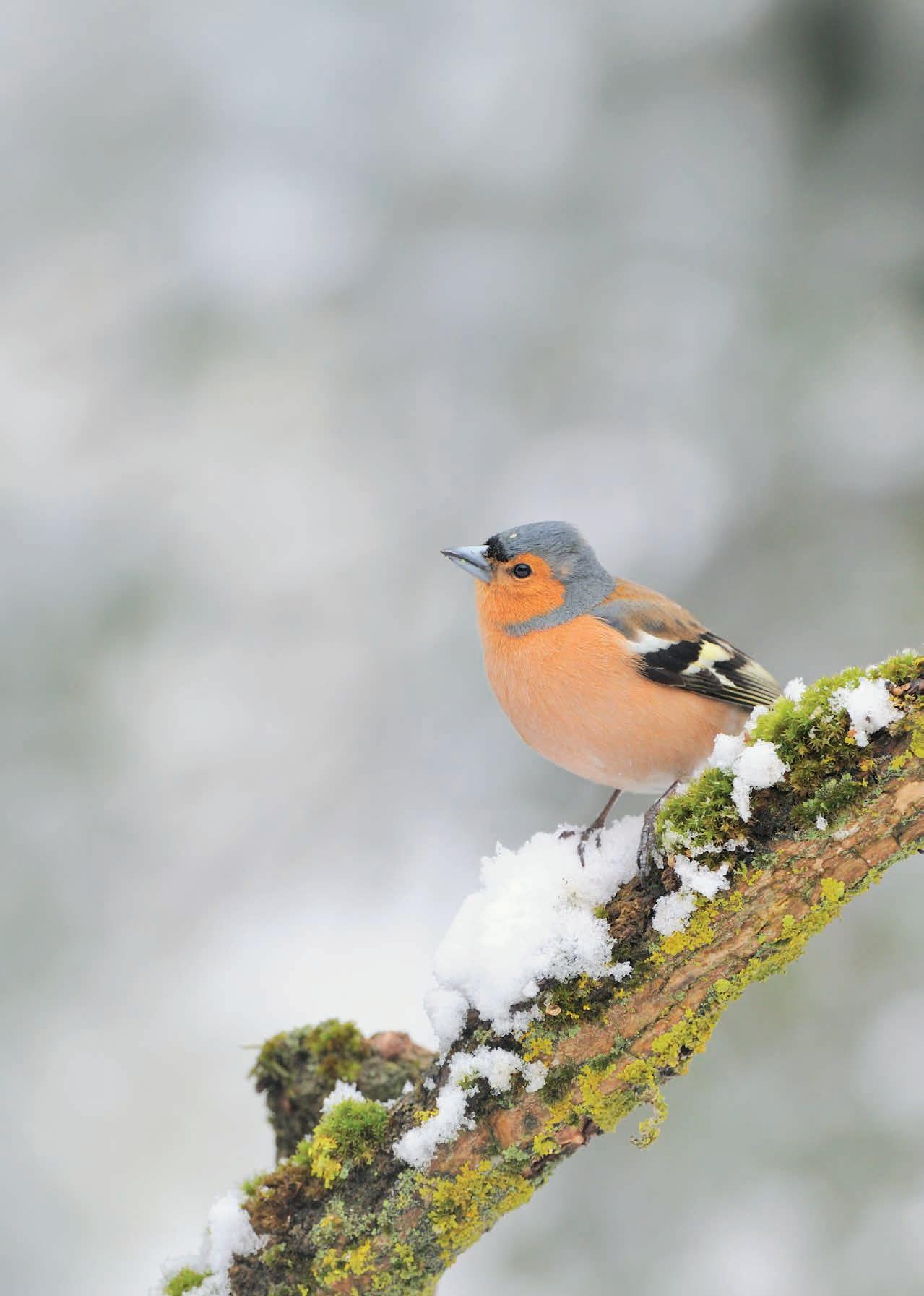


Treat your loved ones to a membership of Leicestershire and Rutland Wildlife Trust this Christmas.
It’s the gift that keeps on giving for the whole year! Show someone special that you care while supporting our vital work for wildlife across Leicestershire and Rutland.
Your friend or family member will receive a membership welcome pack, including a packed 110-page guide to our nature reserves and local wildlife, our Wild Leicestershire and Rutland magazine three times a year, exclusive access to member events, newsletters and more.

Thinking of sending Christmas cards by post? Ditch the spiralling postage costs and send them an e-card instead. Christmas e-cards sent through our website are super-convenient and include a small donation to support our work.
lrwt.org.uk/christmas

Invite friends and family to help protect nature and wildlife across Leicestershire and Rutland this festive season.






